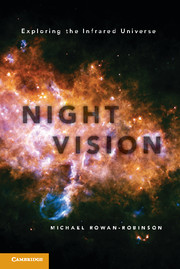Book contents
- Frontmatter
- Contents
- Preface
- 1 Introduction
- 2 William Herschel Opens Up the Invisible Universe
- 3 1800–1950
- 4 Dying Stars Shrouded in Dust and Stars Being Born
- 5 Birth of Submillimetre Astronomy
- 6 The Cosmic Microwave Background, Echo of the Big Bang
- 7 The Infrared Astronomical Satellite and the Opening Up of Extragalactic Infrared Astronomy
- 8 The Cosmic Background Explorer and the Ripples, the Wilkinson Microwave Anisotropy Probe and Dark Energy
- 9 Giant Ground-Based Near-Infrared and Submillimetre Telescopes
- 10 The Infrared Space Observatory and the Spitzer Space Telescope
- 11 Our Solar System’s Dusty Debris Disk and the Search for Exoplanets
- 12 The Future
- Epilogue
- Notes
- Credits for Illustrations
- Glossary
- Further Reading
- Bibliography
- Name Index
- Subject Index
11 - Our Solar System’s Dusty Debris Disk and the Search for Exoplanets
Published online by Cambridge University Press: 05 March 2013
- Frontmatter
- Contents
- Preface
- 1 Introduction
- 2 William Herschel Opens Up the Invisible Universe
- 3 1800–1950
- 4 Dying Stars Shrouded in Dust and Stars Being Born
- 5 Birth of Submillimetre Astronomy
- 6 The Cosmic Microwave Background, Echo of the Big Bang
- 7 The Infrared Astronomical Satellite and the Opening Up of Extragalactic Infrared Astronomy
- 8 The Cosmic Background Explorer and the Ripples, the Wilkinson Microwave Anisotropy Probe and Dark Energy
- 9 Giant Ground-Based Near-Infrared and Submillimetre Telescopes
- 10 The Infrared Space Observatory and the Spitzer Space Telescope
- 11 Our Solar System’s Dusty Debris Disk and the Search for Exoplanets
- 12 The Future
- Epilogue
- Notes
- Credits for Illustrations
- Glossary
- Further Reading
- Bibliography
- Name Index
- Subject Index
Summary
Apart from the Sun, everything in the Solar System emits the bulk of its energy in the infrared. Of course, in reflected optical light from the Sun we do see the planets, comets, zodiacal dust and asteroids, and much of what we have learned about the Solar System has come from optical telescopes. But to see the full picture and make the connection with other planetary systems, we need the infrared vision of the Solar System. We have seen that the infrared space missions IRAS, ISO and Spitzer made a series of discoveries about the Solar System and other planetary systems. In particular, the discovery by IRAS of dust debris disks opened the way for the exploration of other planetary systems in the process of formation. In this chapter, we focus on the debris disk in our own solar system: the asteroid belt, the zodiacal cloud, the Kuiper Belt, and comets and Centaurs. This leads on naturally to the exciting search for planets around other stars and ultimately for planets like Earth which could sustain life.
The five visible planets – Mercury, Venus, Mars, Jupiter and Saturn – have been known and studied since antiquity. In 1543, Nicolaus Copernicus (1473–1543) gave us our modern picture of the planets, including the Earth, orbiting the Sun in approximately a common plane, the ecliptic plane, with the Moon orbiting the Earth. In 1605, Johannes Kepler (1571–1630) showed that the orbits of the planets were approximately ellipses, and Newton in 1687 explained these orbits in terms of the inverse-square law of gravitation. The seventeenth century also saw the discoveries of moons around Jupiter by Galileo in 1610 and of Saturn’s moon Titan by Huygens in 1655. As we saw in Chapter 2, William Herschel discovered Uranus in 1781, and the eighth planet, Neptune, was discovered by Urbain Leverrier (1811–1877) and Jean-Couch Adams (1819–1892) in 1846. The nineteenth century also saw the discovery of asteroids in orbit between Mars and Jupiter and the discovery of the moons Phobos and Deimos around Mars.
- Type
- Chapter
- Information
- Night VisionExploring the Infrared Universe, pp. 155 - 167Publisher: Cambridge University PressPrint publication year: 2013



